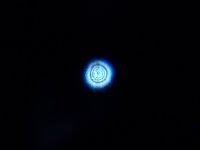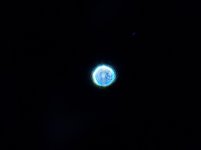How do you like the TE-80 over the zoom? I couldn't find any reviews of it and i am really interested in some opinions as i have to decide between the two. Anybody else that has tried it, do you like it? I have looked through the old kowa 30x and the 25-60x and seem to prefere the fixed power. Sorry if it's not related to the discussed subject.I have been following the discussion about the TSN-99 with great interest.
After selling my 883 in October I bought a 99a about 4 weeks ago at my local dealer including the TE-80Ww. I already owned the TE-11 zoom plus two 1.6 converters.
On my 883, I had used the two converters for magnification above 100x and it worked to some extent watching moon and planets.
I found no weather situation to do a star test up to now, but will do so if I have any chance. My 883 showed some SA, but I guess my adapters DA4/DA4 plus my camera (Sony RX 100 II) might be part of the problem because, if I understand the procedure, the camera lens must be 100% the same horizontal and vertical level of the scope lens. Else there will of course be image faults whatsoever.
I did this picture of a Sparrowhawk today through a double glass pane of our garden door with the 88a, the TE 80 and a 1.6 converter. So this is 64x magnification, and this first shot is promising. Being more interested in birding than in astronomy, I feel the extra light compared to the 883 helpful with my 71-year old eyes that are slowly building a cataract.
If the star test I'm going to do is disappointing, I will look for an astronomical telescope instead of putting down my 99a.
I have already started looking around for an Astro Physics Stowaway or Traveler.
At the moment, the 99a is alternately used on a Gitzo tripod (steel) with a Gitzo G2380 head and a Berlebach Uni 16c with a Pegasus head.
To sum up my personal review: I like my 99a plus the TE-80 and will not return it. It's too late anyway....
-
Welcome to BirdForum, the internet's largest birding community with thousands of members from all over the world. The forums are dedicated to wild birds, birding, binoculars and equipment and all that goes with it.
Please register for an account to take part in the discussions in the forum, post your pictures in the gallery and more.
You are using an out of date browser. It may not display this or other websites correctly.
You should upgrade or use an alternative browser.
You should upgrade or use an alternative browser.
Any customer review of new tsn-99? (1 Viewer)
- Thread starter jcwu88
- Start date
More options
Who Replied?paperweight
Well-known member
How do you like the TE-80 over the zoom? I couldn't find any reviews of it and i am really interested in some opinions as i have to decide between the two. Anybody else that has tried it, do you like it? I have looked through the old kowa 30x and the 25-60x and seem to prefere the fixed power. Sorry if it's not related to the discussed subject.
I think it's good to have both of them: for digiscoping I prefer the TE-80 because it's sharp from the centre to the corners. I can still crop the shot afterwards. For birding, I like the TE-11 because I can zoom in when I want to watch details like feathers etc.
When I started with my 883, I had two eyepieces, the TE-10 zoom and the TE-17 30x. I later bought the new TE-11 zoom and sold the TE-17.
But the more I turned to digiscoping, the more I found a fixed mag offers more sharpness. BTW: I found the TE-10 to be better suited for digiscoping than the TE-11.
When I decided to get the TSN-99a, I had a look through the TE-80 and was convinced from the start.
binomania
Well-known member
Hi. I am preparing a complete video review. i ho pe to publish It, after 20 february. Regards from ItalyJust wondering if anyone got this new scope and share their opinions?
binomania
Well-known member
It's incredible.The specimen that i've in vision show no C.A.at 70x ..also with bad illumination,please It you have Facebook se my short videoclip In this type of condition by phonescoping or digiscoping i've seen often C.A. in Swarovski ATX 95, by the way i will show my result in the videoreviewI currently have a specimen of the Tsn-99 here with me at home. I own a Meopta Meostar S2 82 HD, a friend of mine owns a Swaro ATX 85 and another friend owns a Kowa TSN 883. Today we had the chance to compare those scopes side by side. Here are my personal results (concentrating on optical quality only):
1st place: Kowa TSN 883. Crystal clear and brillant image (even at max magnification) with perfect sharpness and color, no CAs at all. Focusing is easy, Eye relief very good.
2nd: Meopta. Also very clear image, with a tiny hinge of a warmish tint. At max magnification, focussing gets more difficult, the image is a bit softer. No CAs, good eye relief.
3rd: Swaro. Slightly visible CAs at height magnifications. Bright image, at low light better than the Meopta.
4th: Kowa 99. At magnifications of 50-70 very soft and almost foggy image compared to the other scopes. Visible CAs. Clearly worse than the other scopes. I might do some star testing tonight, but I am definitely not going to keep this scope.
henry link
Well-known member
I still have two TSN-993 specimens in my possession, but I'll be returning them tomorrow or the next day.
I've been working at improving my indoor star-testing set-up and only recently discovered that my iPhone flashlight is a super bright light source and easily provides a usably bright and tiny star point using the 50 micron pinhole from my Hubble Optics artificial star. It's small enough at 10 meters for 100mm+ telescopes and bright enough for decent star test photos using a Baader Solar Continuum narrow band green filter, which I've never had enough light before to use for photos.
The PDF below shows star-tests in both "white" light, meaning in this case the flashlight LED on my iPhone with the camera's white balance (Nikon D-5600) set for tungsten and very narrow band green light centered at 539 nm from the Baader filter placed over the flashlight lens and the 50 micron pinhole.
As you can see the main problems with this specimen (the scope Kowa sent me as a replacement for the first one) are astigmatism, some coma and spherical aberration. Notice that the SA improves in the narrow band green light of the filter, which Baader claims eliminates the effects of spherochromatism and secondary color on a star test. The first scope I received (which has almost no astigmatism) shows little improvement in SA in green light. Visually, this scope has a slightly worse image and a little lower resolution than the first one. I'll post a PDF of my indoor star-tests of the first first Kowa scope I received in white and green light as well as my Nikon Monarch ED in the next few days.
Henry
I've been working at improving my indoor star-testing set-up and only recently discovered that my iPhone flashlight is a super bright light source and easily provides a usably bright and tiny star point using the 50 micron pinhole from my Hubble Optics artificial star. It's small enough at 10 meters for 100mm+ telescopes and bright enough for decent star test photos using a Baader Solar Continuum narrow band green filter, which I've never had enough light before to use for photos.
The PDF below shows star-tests in both "white" light, meaning in this case the flashlight LED on my iPhone with the camera's white balance (Nikon D-5600) set for tungsten and very narrow band green light centered at 539 nm from the Baader filter placed over the flashlight lens and the 50 micron pinhole.
As you can see the main problems with this specimen (the scope Kowa sent me as a replacement for the first one) are astigmatism, some coma and spherical aberration. Notice that the SA improves in the narrow band green light of the filter, which Baader claims eliminates the effects of spherochromatism and secondary color on a star test. The first scope I received (which has almost no astigmatism) shows little improvement in SA in green light. Visually, this scope has a slightly worse image and a little lower resolution than the first one. I'll post a PDF of my indoor star-tests of the first first Kowa scope I received in white and green light as well as my Nikon Monarch ED in the next few days.
Henry
Attachments
Last edited:

The outside focus in Henry's focus looks like that in the copy I had.
BoldenEagle
Well-known member

That's really great customer care...As you can see the main problems with this specimen (the scope Kowa sent me as a replacement for the first one) are astigmatism, some coma and spherical aberration.
Regards, Juhani
henry link
Well-known member
Here are the star test photos of the first Kowa TSN-993 I received presented in the same white light/green light format I used for the second specimen in post #125.
Notice that in this scope the spherical aberration doesn't improve much in green light, so I think it's safe to say that this really is spherical aberration and not some form of color interference. I also tried a 1/3 central obstruction as suggested by Suiter with inconclusive results. I'll play around with that more in the future, but I've reached star-test fatigue for the moment.
I'm not sure why there seems to be so much coma in the 2-ring photos, but not so much in the focused star. The zone looks pretty severe, but I still don't know how much effect it has on image quality. This scope was visually superior to the second astigmatic one, although still not diffraction limited.
Henry
Notice that in this scope the spherical aberration doesn't improve much in green light, so I think it's safe to say that this really is spherical aberration and not some form of color interference. I also tried a 1/3 central obstruction as suggested by Suiter with inconclusive results. I'll play around with that more in the future, but I've reached star-test fatigue for the moment.
I'm not sure why there seems to be so much coma in the 2-ring photos, but not so much in the focused star. The zone looks pretty severe, but I still don't know how much effect it has on image quality. This scope was visually superior to the second astigmatic one, although still not diffraction limited.
Henry
Attachments
BoldenEagle
Well-known member

I received sixth sample of Kowa 99A and here are the star test results:
In this sample SA seemed to be better than in any former samples I've had, not perfect yet but on the outside pattern there were quite a few inner rings to be seen. In the inside pattern, there seemed to be bright central zone and the rings were not perfectly round, a bit of triangular but not nearly as bad as in some former samples has been.
There was some amount of astigmatism, though not very severe I think.
Collimation was definetely off a bit.
Prism roof line was evident as usual.
I used this scope in my yard before doing star test and find the image quality very good at lower mags. and also 70x seemed quite good actually. I made some direct comparisons with my 883 indoors using illuminated 50€ bill @96x and found that this 99A sample was lagging sharpness and contrast a little bit; it had slightly more hazy image and with 883 it was easier to see smallest details, allthough the difference was not dramatic (but still there).
So this sample was the best 99A I have seen so far. Maybe without the coma+astigmatism this one would have been a keeper since the SA was relatively good?
Regards, Juhani
In this sample SA seemed to be better than in any former samples I've had, not perfect yet but on the outside pattern there were quite a few inner rings to be seen. In the inside pattern, there seemed to be bright central zone and the rings were not perfectly round, a bit of triangular but not nearly as bad as in some former samples has been.
There was some amount of astigmatism, though not very severe I think.
Collimation was definetely off a bit.
Prism roof line was evident as usual.
I used this scope in my yard before doing star test and find the image quality very good at lower mags. and also 70x seemed quite good actually. I made some direct comparisons with my 883 indoors using illuminated 50€ bill @96x and found that this 99A sample was lagging sharpness and contrast a little bit; it had slightly more hazy image and with 883 it was easier to see smallest details, allthough the difference was not dramatic (but still there).
So this sample was the best 99A I have seen so far. Maybe without the coma+astigmatism this one would have been a keeper since the SA was relatively good?
Regards, Juhani
Attachments

The 2nd copy I received a few days ago is better than the 1st. The STP (Star Test Pattern) is similar to Henry's 2nd copy. Apparent resolution seems to be equal to my ATX95. Contrast might be a touch less. Hope to try it out on some actual birds in the next few days once it warms up a bit and an incoming 1.6x arrives. The 99 arrived half an hour before a snowstorm hit on Thursday and I've not really had much chance to mess with it yet.
I've found the ST Pattern to be easier to evaluate when using Polaris than with a flashlight and pinhole foil mask.
I've found the ST Pattern to be easier to evaluate when using Polaris than with a flashlight and pinhole foil mask.
henry link
Well-known member
Thought I would mention two bits of information about the TSN-993 that came my way while I had the scopes. Firstly, I was told by Kowa that the focal length is 583mm and secondly I found that the Baader Hyperion MK IV zoom could not reach infinity focus in the 993 using the Kowa 1.25" grub screw adapter. That adapter allows the eyepiece body and the scope body to screw tightly together, so I don't think there is any way to add more in-focus.
I add input to Henry test:Thought I would mention two bits of information about the TSN-993 that came my way while I had the scopes. Firstly, I was told by Kowa that the focal length is 583mm and secondly I found that the Baader Hyperion MK IV zoom could not reach infinity focus in the 993 using the Kowa 1.25" grub screw adapter. That adapter allows the eyepiece body and the scope body to screw tightly together, so I don't think there is any way to add more in-focus.
Baader Morpheus 12.5mm can reach infinity focus;
Morpheus 17.5 mm can’t reach infinity.
Explore Scientific 68degrees 24mm can reach infinity.
Explore Scientific all 82 degrees eyepieces can’t reach focus due to their long 1.25” tubes.

After further review I'll be returning the 2nd copy. The ST inner results appeared very good with perhaps slight astigmatism. The outer focus view had a larger center disc and a dimmer outer ring. Performance was pretty good up to 50x-60x, but deteriorated at 70x, especially compared to my S2 and ATX95. At 70x contrast seemed to be more of an issue than resolution. Very disappointing given my memory of the 883 I examined about a year ago. It resolved slightly better than my S2 and was noticeably clearer in dim conditions. Really expected better from a $4k scope. I doubt I'll be looking at additional samples, hate ordering stuff and returning it.The 2nd copy I received a few days ago is better than the 1st. The STP (Star Test Pattern) is similar to Henry's 2nd copy. Apparent resolution seems to be equal to my ATX95. Contrast might be a touch less. Hope to try it out on some actual birds in the next few days once it warms up a bit and an incoming 1.6x arrives. The 99 arrived half an hour before a snowstorm hit on Thursday and I've not really had much chance to mess with it yet.
I've found the ST Pattern to be easier to evaluate when using Polaris than with a flashlight and pinhole foil mask.
BoldenEagle
Well-known member

This has been a pain in the ass for me also.I doubt I'll be looking at additional samples, hate ordering stuff and returning it.
And I also decided that I won't actively try to find good 99A sample anymore, since it seems that they are so rare. I'm pretty good with my current 883.
Regards, Juhani

I'm sorta wishing I kept the 883 I had a year ago. I may try replacing my ATX 95mm module with an 85mm and repurchasing the 1.7x extender. It would be more appropriate on my 128RC head. The ATX eyepiece diameter is still too large for my taste, but the panning dampening of the 128RC is better than most typical birding heads and my big fat nose will push it around a little less.This has been a pain in the ass for me also.
And I also decided that I won't actively try to find good 99A sample anymore, since it seems that they are so rare. I'm pretty good with my current 883.
Regards, Juhani
paperweight
Well-known member
I did a comparison between the TE-11 without the 1.6 extender (=70x mag) and the TE-80 with the extender (=64x mag) on my TSN-99a.
What I found is that the combination of TE-80 and extender needs less light than the TE-11 on its own. With the same aperture on my Sony RX-100 II (3.7) I had to go from 1/250sec in the first shot (TE-11) to 1/500sec in the second shot (TE-80/Ext. 1.6)
The air was moving a lot due to the warm temperature and the full sun blasting on the ground. The telephone converter is about a mile from where I shot, and of course the white circula antenna is way over-exposed.
TE 11
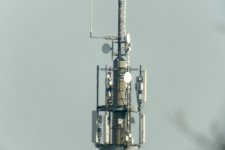
TE 80/Ext 1.6
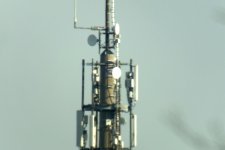
I can't explain the larger magnification in the second picture. I had to take off the DA4/DA10 digiscoping adapter incl. the camera. Maybe camera zoom was a bit higher than in the first shot.
Finally, I went back to the TE-11 and took this (cropped) picture of a magpie at about 500 metres from my garden:
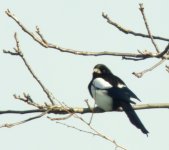
What I found is that the combination of TE-80 and extender needs less light than the TE-11 on its own. With the same aperture on my Sony RX-100 II (3.7) I had to go from 1/250sec in the first shot (TE-11) to 1/500sec in the second shot (TE-80/Ext. 1.6)
The air was moving a lot due to the warm temperature and the full sun blasting on the ground. The telephone converter is about a mile from where I shot, and of course the white circula antenna is way over-exposed.
TE 11

TE 80/Ext 1.6

I can't explain the larger magnification in the second picture. I had to take off the DA4/DA10 digiscoping adapter incl. the camera. Maybe camera zoom was a bit higher than in the first shot.
Finally, I went back to the TE-11 and took this (cropped) picture of a magpie at about 500 metres from my garden:

Last edited:
Looks great. How is the TE80 visual observations comparing to TE-11z? Resolution and CA? Thank youI did a comparison between the TE-11 without the 1.6 extender (=70x mag) and the TE-80 with the extender (=64x mag) on my TSN-99a.
What I found is that the combination of TE-80 and extender needs less light than the TE-11 on its own. With the same aperture on my Sony RX-100 II (3.7) I had to go from 1/250sec in the first shot (TE-11) to 1/500sec in the second shot (TE-80/Ext. 1.6)
The air was moving a lot due to the warm temperature and the full sun blasting on the ground. The telephone converter is about a mile from where I shot, and of course the white circula antenna is way over-exposed.
TE 11
View attachment 1435764
TE 80/Ext 1.6
View attachment 1435765
I can't explain the larger magnification in the second picture. I had to take off the DA4/DA10 digiscoping adapter incl. the camera. Maybe camera zoom was a bit higher than in the first shot.
Finally, I went back to the TE-11 and took this (cropped) picture of a magpie at about 500 metres from my garden:
View attachment 1435775
Similar threads
- Replies
- 10
- Views
- 5K
Users who are viewing this thread
Total: 2 (members: 0, guests: 2)





